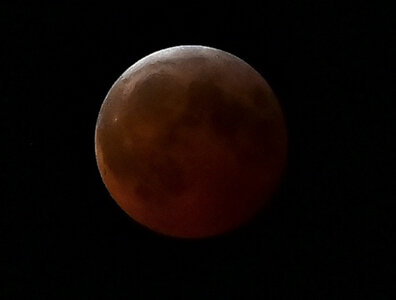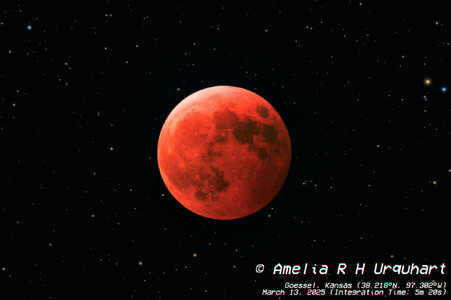gdlewen
EF4
I'm interested in seeing the images ST members have of the total lunar eclipse on 3/14/2025.
Here is mine, taken a little after totality. There is a bright spot which I think is the crater Aristarchus. What struck me was how the normally sharp features are blurred, and this is "real" because the edge of the moon's disk is sharp so the image is in focus. Also, I don't think the blurring is due to the fact the image is "darkened".
Obviously the dark red color is due to scattering in the earth's atmosphere, but I never before considered that the atmosphere just doesn't redden the light, it also creates a diffuse annular light source that is very different from the plane-parallel light normally incident on the lunar surface--in the absence of the eclipse.
I'm doing a search for papers that quantify how this diffuse light affects imaging the moon's surface from the earth, but so far it is a bit slow. Lots of discussion of color-shifts and how scattering changes the light distribution across the lunar disk but so far none taking the extra step to discuss effects on subsequent imaging. (That's a long way of asking if anyone can provide some references.... Thanks!)
Here is mine, taken a little after totality. There is a bright spot which I think is the crater Aristarchus. What struck me was how the normally sharp features are blurred, and this is "real" because the edge of the moon's disk is sharp so the image is in focus. Also, I don't think the blurring is due to the fact the image is "darkened".
Obviously the dark red color is due to scattering in the earth's atmosphere, but I never before considered that the atmosphere just doesn't redden the light, it also creates a diffuse annular light source that is very different from the plane-parallel light normally incident on the lunar surface--in the absence of the eclipse.
I'm doing a search for papers that quantify how this diffuse light affects imaging the moon's surface from the earth, but so far it is a bit slow. Lots of discussion of color-shifts and how scattering changes the light distribution across the lunar disk but so far none taking the extra step to discuss effects on subsequent imaging. (That's a long way of asking if anyone can provide some references.... Thanks!)
Last edited:



